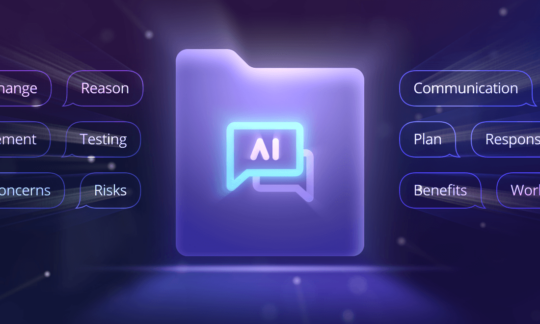Demystifying Chatbots in Banking: All You Need to Know
Table of contents
- What Are Chatbots for Banking?
- How to Use Chatbots in Banking
- Using Chatbots and Voicebots in the Banking Industry: The Benefits
- Cons of Chatbots in Banking
- Some Banks Are Already Riding the Wave
- Meet (Just Some of) the Bots
- Emerging Trends in the World of Banking Chatbots
In the current age of ever-progressing technology, the days of physically having to spend whole days running errands are long gone. Customers safeguard their precious time and welcome any and all opportunity to facilitate pressing activities. Banking has benefitted from this particularly noticeably, as the presence of chatbots and voicebots in the finance industry, hardly measurable just 10 years ago, has now increased dramatically, and will continue to do so.
The Financial Brand states that banks could see a 22% reduction in operating costs through the implementation of artificial intelligence solutions. Clearly, conversational AI in banking is on the rise, and the reasoning behind it is evident. To gain a competitive edge, financial institutions need to familiarize themselves with the ins and outs of this particular aspect of digital banking, lest they fall behind on the market and bleed customers to banks focusing more on reliable, versatile, and cost effective user experience solutions.
What Are Chatbots for Banking?
In essence, chatbots for banking are deployed to minimize the need for customers to interact with human employees for simple tasks and easily solvable problems. One of the benefits of chatbots in the banking sector is their full availability. They don’t need to sleep, eat or go on coffee breaks, meaning customers can get the help they need exactly when they need it, without having to be kept on hold.
It’s important to stress – this isn’t a maybe, it’s happening right now. Chatbots and voicebots are rising in popularity among financial institutions, and EY predicts that by 2030, almost all customer service interactions with conversational AI will be nigh indistinguishable from real person contact.
How to Use Chatbots in Banking
We’ve got the basic grasp of the technology. But what is it actually good for? To better understand this, let’s reverse engineer the most common reasons customers contact their banks for.
Basic Customer Service
These examples can range from answering questions about some of the bank’s available services through locating the nearest physical branch, providing account details, reporting theft and requesting a card or account to be blocked for suspicion of fraud, to performing money transfers. A well-designed chatbot should be able to perform a range of basic functions without the need to have a human consultant step in.
Notifications and Reminders
Money is a sensitive topic. Nobody likes to feel the pressure of accidentally falling behind on their due payments and expecting the hammer of justice to fall upon them in reckoning for what was just an honest oversight. Chatbots can be used to that very end, helping the by no means small subset of people who live busy, fast-paced lives by reminding them about deadlines and special offers.
Customer Feedback
The banking industry can use chatbots to collect information and opinions from its customers to constantly evolve and strive to provide a higher quality service. Bonus points are due for preventing users from shouting consultants’ ears off when they encounter friction, and end up having a less than satisfactory experience.
Sales and Acquisition
Chatbots can be programmed for sales purposes as well. Be it recommending a new product or signing up a new customer from the first interaction, they offer a versatile and largely hands-off way for banks to expand their client base.
Steering Calls
When all else fails, and the AI cannot functionally replace a human agent (or when the client simply doesn’t fancy talking to a chatbot), the conversation can easily be forwarded to a consultant from the appropriate department or team. They will receive all the information the chatbot gathered throughout their interaction with the client, making the rest of the process smoother for both parties.
Using Chatbots and Voicebots in the Banking Industry: The Benefits
1. Cost Effective
By far the biggest advantage of NLP-based automation in banking is the cost effectiveness. A human cannot work 24/7, while an AI was designed to be available at any time. This frees up human resources in banks, resulting in cost savings. It’s therefore no surprise conversational AI in financial services is expected to see astronomical growth, with over $100 billion in investments by 2025.
2. Efficient & Better Service (for Both Sides)
If a chatbot is quick and easy to use, both parties benefit. Clients enjoy a hassle-free service, while banks can gather the information the client provided, save it, and use it for future operations. Human agents remain occupied with more pressing matters, which also reduces the risk of human error, since bots cannot provide any wrong information. Additionally, banks can raise the bar even higher by introducing voicebots, a technology utilizing voice, to make the experience flow even more smoothly. This solution will be especially true if an advanced AI-based language model is used, as such voicebots are capable of appropriate responses in more complex matters, further limiting the need for human involvement.
3. Increased Personalization
With 71% of customers feeling frustration toward impersonal experiences, adapting the service to the customer has become somewhat of a transindustrial standard, and banking is no exception. The good news is that chatbots can help make your way toward that goal. How? Remember, they have access to records – possibly made during past chatbot conversations – and can adapt the responses to each customer’s situation. On the contrary, calling the bank’s traditional support line means pretty much guaranteeing you get a different agent every time, and manual record-keeping may vary from very orderly to lax at best. Using chatbots is a simple workaround for this problem, allowing documentation to be organized in a uniform way across the board, and cutting down on time spent searching through past conversations with each individual customer.
Cons of Chatbots in Banking
Of course, no solution is perfect. The technology still has its certain limitations, and proactively thinking of these obstacles can help you adapt your chosen approach to the customer experience.
They Can’t Do It All
First of all, banking chatbots have limited functionality. Their ability to solve problems is strictly correlated to what questions they were programmed to respond to. One unexpected query can throw the whole system for a loop and leave you with an irate customer, ready to take out their frustration on the poor soul who picks up the transferred call.
Lack of Personality
Next, we just mentioned personalization as an important puzzle piece. Well, chatbots aren’t exactly the biggest charmers, and scripted answers prepared by the algorithm don’t allow for flexibility or authenticity. And since most customers don’t like when the conversation lacks a human factor, they’re also less likely to consider the experience positive.
Errors Still Happen
Finally, technical issues and limitations may throw a wrench in the works. Chatbots operate based on customer input, so if the customer is providing false information to impersonate someone, or even if they simply misspell a word, the chatbot may give out inappropriate answers. In the latter case the consequences are rather benign and would simply require feeding the algorithm extra dialogue options, but the former situation could result in fraud, theft, and an overall bad time for everyone involved.
Some Banks Are Already Riding the Wave
HSBC
Meet Amy from HSBC. She was first introduced as the bank’s newest digital banking solution in 2018, one of the first in the industry. She can easily answer customer questions in three different languages, interact with thousands of people at the same time, and is seamlessly integrated into HSBC’s array of other digital banking services.
Bank of America
Erica, Bank of America’s virtual assistant is equally unmatched when it comes to providing individual clients with basic support, like informing them about account balances, credit scores, or refund confirmations. She can also send payment reminders and even give investment insights!
Qatar Insurance Company
QIC’s chatbot boasts great responsiveness, and has proven itself as one of their main selling channels from the moment it was introduced. With high uptime and multi-channel deployment, this banking chatbot is living proof (if you can say that) of the technology performing to an already exceptional standard.
Meet (Just Some of) the Bots
SentiOne Automate
SentiOne clients utilise the conversational AI platform, Automate, to develop multilingual chatbots and voicebots in English, German, Spanish, and Arabic. Our market-leading natural language understanding (NLU) achieves an intent accuracy rate of 96%. Furthermore, SentiOne AI chatbots enable you to attain a 40% automation rate in customer service processes.
Tars
Easy to setup, even easier to use, Tars has found commercial success, particularly in the finance sector. They even claim that their chatbot can increase conversion rates up to three times!
Haptik
Haptik’s Smart Skills virtual assistants are trained on over 3 billion conversations. Their solution for financial services was built to automate 70–80% of queries and provide an impeccably personalized service thanks to the natural language used by the chatbot.
Emerging Trends in the World of Banking Chatbots
So, what’s next in the industry? With investments pouring in by the billions, some really impressive statistics, and the general public receiving a knowledge bomb in the form of the widespread publicity received by ChatGPT, conversational AI in banking will be sprinting ahead.
As banks adapt their digital services to the evolving market, chatbots stand right beside them as the loyal sidekick, leading the charge in elevating customer experience to match the busy client’s rising expectations.
Since the lack of a human element and impersonality are the biggest drawbacks of chatbots by far, advancing the technology to make chatbots more human-like has the most room for improvement. As the algorithms behind digital assistants become more sophisticated, accessible, and cheap, their presence on the market will expand. And the business sector has already accepted this inevitability, with 83% of senior leaders expressing their willingness to adopt intelligent tech, according to Accenture.
When it comes to voicebots, support for voice-based AI is fledgling among the public, though the technology is undoubtedly rife with potential. PwC claims that around 90% of respondents are not familiar with voice-activated technology. The other 10% favor using it for simpler tasks, such as online searches, and withhold their trust when it comes to more serious activities. In spite of all this, the capabilities of voicebots are growing, and their presence in the banking sector will likely expand with time.
All statistics aside, the benefits of using chatbots in banking on the whole greatly outweigh the drawbacks. With thousands of potential man-hours to save and billions of dollars in reduced costs, those in the industry who have not yet implemented AI-powered customer service will not hesitate to do so once they are convinced of its profitability – and that time is not far off.



